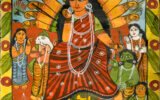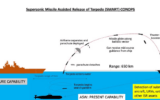
April 02 2024 Prelims Practice Questions (PPQs)
Subscribe to Never Miss an Important Update! Assured Discounts on New Products!
Must Join PMF IAS Telegram Channel & PMF IAS History Telegram Channel
- These Prelims Practice Questions (PPQs) are based on PMF IAS Daily Current Affairs.
- The daily current affairs are uploaded every day by 8 PM. You can read the Daily Current Affairs from here.
- Subscribers of the “Current Affairs” course can Download Daily Current Affairs in PDF/DOC from here.
[Quiz] Daily Prelims Practice Questions (PPQs) – April 02 2024
0 of 9 questions completed
Questions:
- 1
- 2
- 3
- 4
- 5
- 6
- 7
- 8
- 9
Information
These MCQs are based on PMF IAS Daily Current Affairs. The daily current affairs are uploaded every day by 8 PM. You can read the Daily Current Affairs from here. Subscribers of the “Current Affairs” course can Download Daily Current Affairs in PDF/DOC from here.
You have already completed the Test before. Hence you can not start it again.
Test is loading...
You must sign in or sign up to start the Test.
You have to finish following quiz, to start this Test:
Your results are here!! for" [Quiz] Daily Prelims Practice Questions (PPQs) – April 02 2024 "
0 of 9 questions answered correctly
Your time:
Time has elapsed
Your Final Score is : 0
You have attempted : 0
Number of Correct Questions : 0 and scored 0
Number of Incorrect Questions : 0 and Negative marks 0
| Average score |
|
| Your score |
|
-
Not categorized
You have attempted: 0
Number of Correct Questions: 0 and scored 0
Number of Incorrect Questions: 0 and Negative marks 0
| Pos. | Name | Entered on | Points | Result |
|---|---|---|---|---|
| Table is loading | ||||
| No data available | ||||
- 1
- 2
- 3
- 4
- 5
- 6
- 7
- 8
- 9
- Answered
- Review
-
Question 1 of 9
1. Question
Q1. {Envi – Species} Consider the following statements about Caracals:
- They are found in Kutch, the Malwa Plateau and the Aravalli hill range of North India.
- Caracal is listed as Endangered in IUCN Red List.
- National Board for Wildlife has included Caracal under critically endangered species recovery programme.
How many of the above statement(s) is/are correct?
Correct
Explanation
Statement 1 is correct
- Caracals are found mostly in Rajasthan, Gujarat and Madhya Pradesh and are located in Kutch, the Malwa Plateau, the Aravalli hill range.

- Besides India, the caracal is found in several dozen countries across Africa, the Middle East, Central and South Asia.
- They prefer open terrain and drier, scrubby, arid habitats and needs cover.
- They are also found in semi-deserts, steppes, savannah, scrubland, dry forest and moist woodland or evergreen forest.
Statement 2 is incorrect
- IUCN Red List: Least Concern
- Wildlife Protection Act, 1972: Schedule I
- CITES: Appendix I
Statement 3 is correct
- In 2021, the National Board for Wildlife and the Ministry of Environment, Forest and Climate Change included Caracal in the list of Critically Endangered species under critically endangered species recovery programme.
- There are 22 species on the critically endangered species recovery programme:
- Snow Leopard, Bustard (including Floricans), Dolphin, Hangul, Nilgiri Tahr, Marine Turtles, Dugongs, Edible Nest Swiftlet, Asian Wild Buffalo, Nicobar Megapode, Manipur Brow-antlered Deer, Vultures, Malabar Civet, Indian Rhinoceros, Asiatic Lion, Swamp Deer, Jerdon’s Courser, the Northern River Terrapin, Clouded Leopard, Arabian Sea Humpback Whale, Red Panda and Caracal.
Answer: (b) Only two; Difficulty Level: Medium
Incorrect
Explanation
Statement 1 is correct
- Caracals are found mostly in Rajasthan, Gujarat and Madhya Pradesh and are located in Kutch, the Malwa Plateau, the Aravalli hill range.

- Besides India, the caracal is found in several dozen countries across Africa, the Middle East, Central and South Asia.
- They prefer open terrain and drier, scrubby, arid habitats and needs cover.
- They are also found in semi-deserts, steppes, savannah, scrubland, dry forest and moist woodland or evergreen forest.
Statement 2 is incorrect
- IUCN Red List: Least Concern
- Wildlife Protection Act, 1972: Schedule I
- CITES: Appendix I
Statement 3 is correct
- In 2021, the National Board for Wildlife and the Ministry of Environment, Forest and Climate Change included Caracal in the list of Critically Endangered species under critically endangered species recovery programme.
- There are 22 species on the critically endangered species recovery programme:
- Snow Leopard, Bustard (including Floricans), Dolphin, Hangul, Nilgiri Tahr, Marine Turtles, Dugongs, Edible Nest Swiftlet, Asian Wild Buffalo, Nicobar Megapode, Manipur Brow-antlered Deer, Vultures, Malabar Civet, Indian Rhinoceros, Asiatic Lion, Swamp Deer, Jerdon’s Courser, the Northern River Terrapin, Clouded Leopard, Arabian Sea Humpback Whale, Red Panda and Caracal.
Answer: (b) Only two; Difficulty Level: Medium
Unattempted
Explanation
Statement 1 is correct
- Caracals are found mostly in Rajasthan, Gujarat and Madhya Pradesh and are located in Kutch, the Malwa Plateau, the Aravalli hill range.

- Besides India, the caracal is found in several dozen countries across Africa, the Middle East, Central and South Asia.
- They prefer open terrain and drier, scrubby, arid habitats and needs cover.
- They are also found in semi-deserts, steppes, savannah, scrubland, dry forest and moist woodland or evergreen forest.
Statement 2 is incorrect
- IUCN Red List: Least Concern
- Wildlife Protection Act, 1972: Schedule I
- CITES: Appendix I
Statement 3 is correct
- In 2021, the National Board for Wildlife and the Ministry of Environment, Forest and Climate Change included Caracal in the list of Critically Endangered species under critically endangered species recovery programme.
- There are 22 species on the critically endangered species recovery programme:
- Snow Leopard, Bustard (including Floricans), Dolphin, Hangul, Nilgiri Tahr, Marine Turtles, Dugongs, Edible Nest Swiftlet, Asian Wild Buffalo, Nicobar Megapode, Manipur Brow-antlered Deer, Vultures, Malabar Civet, Indian Rhinoceros, Asiatic Lion, Swamp Deer, Jerdon’s Courser, the Northern River Terrapin, Clouded Leopard, Arabian Sea Humpback Whale, Red Panda and Caracal.
Answer: (b) Only two; Difficulty Level: Medium
-
Question 2 of 9
2. Question
Q2. {Envi – Conservation} Consider the following statements about Global Geoparks Network (GGN):
- They are areas with internationally important rocks and landscapes under the umbrella of UNESCO.
- Currently India has a five geopark registered and acknowledged under UNESCO Global Geopark list.
How many of the above statement(s) is/are correct?
Correct
Explanation
Statement 1 is correct
- In 2004, 17 European and 8 Chinese geoparks came together at UNESCO headquarters in Paris to form the Global Geoparks Network (GGN).
- The Global Geoparks Network was founded under the umbrella of UNESCO, headquartered at Paris.
- During the 38th session of UNESCO’s General Conference in 2015, the 195 Member States of UNESCO ratified the creation of a new label, the UNESCO Global Geoparks.
- UNESCO Global Geoparks are areas with internationally important rocks and landscapes, all of which are managed responsibly for conservation, education and sustainable development.
- The GGN is a dynamic network where members work together to share examples of good practice and join together in common projects.
Statement 2 is incorrect
- India is a signatory to the establishment of UNESCO Global Geoparks.
- However, it does not have any legislation and policy for conservation of geoheritages.
- India is one of those countries which do not have a single geopark registered and acknowledged under UNESCO Global Geopark list.
- Geological Survey of India (GSI) identifies sites as National Geological Monuments.
Answer: (a) 1 only; Difficulty Level: Medium
Incorrect
Explanation
Statement 1 is correct
- In 2004, 17 European and 8 Chinese geoparks came together at UNESCO headquarters in Paris to form the Global Geoparks Network (GGN).
- The Global Geoparks Network was founded under the umbrella of UNESCO, headquartered at Paris.
- During the 38th session of UNESCO’s General Conference in 2015, the 195 Member States of UNESCO ratified the creation of a new label, the UNESCO Global Geoparks.
- UNESCO Global Geoparks are areas with internationally important rocks and landscapes, all of which are managed responsibly for conservation, education and sustainable development.
- The GGN is a dynamic network where members work together to share examples of good practice and join together in common projects.
Statement 2 is incorrect
- India is a signatory to the establishment of UNESCO Global Geoparks.
- However, it does not have any legislation and policy for conservation of geoheritages.
- India is one of those countries which do not have a single geopark registered and acknowledged under UNESCO Global Geopark list.
- Geological Survey of India (GSI) identifies sites as National Geological Monuments.
Answer: (a) 1 only; Difficulty Level: Medium
Unattempted
Explanation
Statement 1 is correct
- In 2004, 17 European and 8 Chinese geoparks came together at UNESCO headquarters in Paris to form the Global Geoparks Network (GGN).
- The Global Geoparks Network was founded under the umbrella of UNESCO, headquartered at Paris.
- During the 38th session of UNESCO’s General Conference in 2015, the 195 Member States of UNESCO ratified the creation of a new label, the UNESCO Global Geoparks.
- UNESCO Global Geoparks are areas with internationally important rocks and landscapes, all of which are managed responsibly for conservation, education and sustainable development.
- The GGN is a dynamic network where members work together to share examples of good practice and join together in common projects.
Statement 2 is incorrect
- India is a signatory to the establishment of UNESCO Global Geoparks.
- However, it does not have any legislation and policy for conservation of geoheritages.
- India is one of those countries which do not have a single geopark registered and acknowledged under UNESCO Global Geopark list.
- Geological Survey of India (GSI) identifies sites as National Geological Monuments.
Answer: (a) 1 only; Difficulty Level: Medium
-
Question 3 of 9
3. Question
Q3. {Vulnerable Sections – PVTGs} Consider the following statements about Konda Reddi Tribes:
- Konda Reddi is a Tulu speaking Particularly Vulnerable Tribal Group inhabiting the banks of the river Godavari in Andhra Pradesh.
- Konda Reddis practice Folk Hinduism and have their own institution of social control called Kula Panchayat.
Which of the above statement(s) is/are not correct?
Correct
Explanation
Statement 1 is incorrect
- Konda Reddi is a Particularly Vulnerable Tribal Group inhabiting the banks of the river Godavari and also in the hilly forest tracts of Godavari and Khammam districts of Andhra Pradesh.
- Their mother tongue is Telugu in its purest and chaste form, with a unique accent.
- The Konda Reddi tribe is divided into exogamous septs for regulating matrimonial relations.
- Generally, each sept is exogamous, but certain septs are considered as brother septs, and marriage alliances with brother septs (agnate relations) are prohibited.
Statement 2 is correct
- The primary religion practiced by the Konda Reddi is Folk Hinduism, characterized by local traditions and cults of local deities worshiped at the community level.
- They have their own institution of social control called ‘Kula Panchayat’.
- Each village has a traditional headman called ‘Pedda Kapu’.
- The office of the headman is hereditary, and the headman is also the Pujari (priest) of the village deities.
- They are primarily shifting cultivators and largely depend on flora and fauna of forest for their livelihood.
Answer: (a) 1 Only; Difficulty Level: Medium
Incorrect
Explanation
Statement 1 is incorrect
- Konda Reddi is a Particularly Vulnerable Tribal Group inhabiting the banks of the river Godavari and also in the hilly forest tracts of Godavari and Khammam districts of Andhra Pradesh.
- Their mother tongue is Telugu in its purest and chaste form, with a unique accent.
- The Konda Reddi tribe is divided into exogamous septs for regulating matrimonial relations.
- Generally, each sept is exogamous, but certain septs are considered as brother septs, and marriage alliances with brother septs (agnate relations) are prohibited.
Statement 2 is correct
- The primary religion practiced by the Konda Reddi is Folk Hinduism, characterized by local traditions and cults of local deities worshiped at the community level.
- They have their own institution of social control called ‘Kula Panchayat’.
- Each village has a traditional headman called ‘Pedda Kapu’.
- The office of the headman is hereditary, and the headman is also the Pujari (priest) of the village deities.
- They are primarily shifting cultivators and largely depend on flora and fauna of forest for their livelihood.
Answer: (a) 1 Only; Difficulty Level: Medium
Unattempted
Explanation
Statement 1 is incorrect
- Konda Reddi is a Particularly Vulnerable Tribal Group inhabiting the banks of the river Godavari and also in the hilly forest tracts of Godavari and Khammam districts of Andhra Pradesh.
- Their mother tongue is Telugu in its purest and chaste form, with a unique accent.
- The Konda Reddi tribe is divided into exogamous septs for regulating matrimonial relations.
- Generally, each sept is exogamous, but certain septs are considered as brother septs, and marriage alliances with brother septs (agnate relations) are prohibited.
Statement 2 is correct
- The primary religion practiced by the Konda Reddi is Folk Hinduism, characterized by local traditions and cults of local deities worshiped at the community level.
- They have their own institution of social control called ‘Kula Panchayat’.
- Each village has a traditional headman called ‘Pedda Kapu’.
- The office of the headman is hereditary, and the headman is also the Pujari (priest) of the village deities.
- They are primarily shifting cultivators and largely depend on flora and fauna of forest for their livelihood.
Answer: (a) 1 Only; Difficulty Level: Medium
-
Question 4 of 9
4. Question
Q4. {S&T – IPR – GI} Consider the following statements regarding GI Tagged products in India:
- Every State in India has at least one GI tagged product.
- Agricultural sector has the most number of GI tagged products when compared to other sectors.
- Karnataka has the maximum number of GI tagged products in India.
- A Registered GI is valid for 10 years and can be renewed free of cost on the request of the concerned state.
How many of the above statement(s) is/are not correct?
Correct
Explanation
Statement 1 is correct
- Every State in India has at least one GI Tag.
- A GI tag helps to protect the reputation and uniqueness of a product.
- It prevents unauthorized use of the name or indication. This can help to ensure that consumers get the genuine product and that producers are not undercut by counterfeiters.
- A GI tag can help increase the marketability and price realization of a product.
- It provides consumers with a guarantee of quality and authenticity. This can be especially important for products that are sold in international markets.
Statement 2 is incorrect
- The products in the GI registry fall under five major categories such as Agriculture, Foodstuff, Handicrafts, Manufactured products, and natural products.
- Handicrafts have the most number of GI tagged products when compared to other sectors.

Statement 3 is incorrect
- Tamil Nadu (61) has the maximum number of GI tagged products, followed by the state of Uttar Pradesh and Karnataka.
Statement 4 is incorrect
- A registered GI shall be valid for 10 years and can be renewed on payment of renewal fee.
- The process of renewal involves submitting an application form, a cover letter, and a cheque of ₹3,000 to GI registry.
- Though the government initially helps the societies or applicants in getting GI tags for their products, it doesn’t extend any help in getting the tag renewed.
Answer: (c) Only three; Difficulty Level: Medium
Incorrect
Explanation
Statement 1 is correct
- Every State in India has at least one GI Tag.
- A GI tag helps to protect the reputation and uniqueness of a product.
- It prevents unauthorized use of the name or indication. This can help to ensure that consumers get the genuine product and that producers are not undercut by counterfeiters.
- A GI tag can help increase the marketability and price realization of a product.
- It provides consumers with a guarantee of quality and authenticity. This can be especially important for products that are sold in international markets.
Statement 2 is incorrect
- The products in the GI registry fall under five major categories such as Agriculture, Foodstuff, Handicrafts, Manufactured products, and natural products.
- Handicrafts have the most number of GI tagged products when compared to other sectors.

Statement 3 is incorrect
- Tamil Nadu (61) has the maximum number of GI tagged products, followed by the state of Uttar Pradesh and Karnataka.
Statement 4 is incorrect
- A registered GI shall be valid for 10 years and can be renewed on payment of renewal fee.
- The process of renewal involves submitting an application form, a cover letter, and a cheque of ₹3,000 to GI registry.
- Though the government initially helps the societies or applicants in getting GI tags for their products, it doesn’t extend any help in getting the tag renewed.
Answer: (c) Only three; Difficulty Level: Medium
Unattempted
Explanation
Statement 1 is correct
- Every State in India has at least one GI Tag.
- A GI tag helps to protect the reputation and uniqueness of a product.
- It prevents unauthorized use of the name or indication. This can help to ensure that consumers get the genuine product and that producers are not undercut by counterfeiters.
- A GI tag can help increase the marketability and price realization of a product.
- It provides consumers with a guarantee of quality and authenticity. This can be especially important for products that are sold in international markets.
Statement 2 is incorrect
- The products in the GI registry fall under five major categories such as Agriculture, Foodstuff, Handicrafts, Manufactured products, and natural products.
- Handicrafts have the most number of GI tagged products when compared to other sectors.

Statement 3 is incorrect
- Tamil Nadu (61) has the maximum number of GI tagged products, followed by the state of Uttar Pradesh and Karnataka.
Statement 4 is incorrect
- A registered GI shall be valid for 10 years and can be renewed on payment of renewal fee.
- The process of renewal involves submitting an application form, a cover letter, and a cheque of ₹3,000 to GI registry.
- Though the government initially helps the societies or applicants in getting GI tags for their products, it doesn’t extend any help in getting the tag renewed.
Answer: (c) Only three; Difficulty Level: Medium
-
Question 5 of 9
5. Question
Q5. {S&T – Space} Consider the following statements with respect to Callisto:
- Callisto is Jupiter’s second largest moon and the largest moon in our solar system.
- Ozone is present in the atmosphere of Callisto.
Which of the above statement is/are correct?
Correct
Explanation
Statement 1 is incorrect
- Callisto is Jupiter’s second largest moon after Ganymede and the third largest moon in our solar system, after Ganymede and Titan.
- It’s about the same size as Mercury.
- Callisto was discovered Jan. 7, 1610, by Italian scientist Galileo Galilei along with Jupiter’s three other largest moons: Ganymede, Europa and Io.
Statement 2 is correct
- In a groundbreaking research collaboration featuring Indian scientists, new evidence has been unearthed pointing to the existence of ozone on Callisto, one of Jupiter’s moons.
- Callisto is on the list of possible places where life could exist in our solar system beyond Earth.
- Callisto’s rocky, icy surface is the oldest and most heavily cratered in our solar system.
Answer: (b) 2 only; Difficulty Level: Medium
Incorrect
Explanation
Statement 1 is incorrect
- Callisto is Jupiter’s second largest moon after Ganymede and the third largest moon in our solar system, after Ganymede and Titan.
- It’s about the same size as Mercury.
- Callisto was discovered Jan. 7, 1610, by Italian scientist Galileo Galilei along with Jupiter’s three other largest moons: Ganymede, Europa and Io.
Statement 2 is correct
- In a groundbreaking research collaboration featuring Indian scientists, new evidence has been unearthed pointing to the existence of ozone on Callisto, one of Jupiter’s moons.
- Callisto is on the list of possible places where life could exist in our solar system beyond Earth.
- Callisto’s rocky, icy surface is the oldest and most heavily cratered in our solar system.
Answer: (b) 2 only; Difficulty Level: Medium
Unattempted
Explanation
Statement 1 is incorrect
- Callisto is Jupiter’s second largest moon after Ganymede and the third largest moon in our solar system, after Ganymede and Titan.
- It’s about the same size as Mercury.
- Callisto was discovered Jan. 7, 1610, by Italian scientist Galileo Galilei along with Jupiter’s three other largest moons: Ganymede, Europa and Io.
Statement 2 is correct
- In a groundbreaking research collaboration featuring Indian scientists, new evidence has been unearthed pointing to the existence of ozone on Callisto, one of Jupiter’s moons.
- Callisto is on the list of possible places where life could exist in our solar system beyond Earth.
- Callisto’s rocky, icy surface is the oldest and most heavily cratered in our solar system.
Answer: (b) 2 only; Difficulty Level: Medium
-
Question 6 of 9
6. Question
Q6. {Prelims – Initiatives} Which of the following statement about PM-SUMAN Scheme is not correct?
Correct
Explanation
- Prime Minister Surakshit Matritva Aashwasan (SUMAN) is an Initiative for Zero Preventable Maternal and Newborn Deaths.
- It is a maternity benefit program that provides affordable healthcare services to pregnant women and newborns.
- It is launched by Ministry of Union Health and Family Welfare (MoHFW) in 2019.
- Objectives:
- This scheme offers zero expenses and access to detection and management of complications during and after pregnancy.
- Pregnant women can avail a zero-expense delivery and C-section facility at public health facilities.
- It ensures zero-tolerance for denial of services to children and pregnant women.
- Pregnant women also receive free transport from home to the health facility and drop back after discharge.
- Facilities such as services for sick newborns and neonates are offered vaccination at zero cost.
Answer: (a) It is an initiative of Ministry of Women and Child Development; Difficulty Level: Medium
Incorrect
Explanation
- Prime Minister Surakshit Matritva Aashwasan (SUMAN) is an Initiative for Zero Preventable Maternal and Newborn Deaths.
- It is a maternity benefit program that provides affordable healthcare services to pregnant women and newborns.
- It is launched by Ministry of Union Health and Family Welfare (MoHFW) in 2019.
- Objectives:
- This scheme offers zero expenses and access to detection and management of complications during and after pregnancy.
- Pregnant women can avail a zero-expense delivery and C-section facility at public health facilities.
- It ensures zero-tolerance for denial of services to children and pregnant women.
- Pregnant women also receive free transport from home to the health facility and drop back after discharge.
- Facilities such as services for sick newborns and neonates are offered vaccination at zero cost.
Answer: (a) It is an initiative of Ministry of Women and Child Development; Difficulty Level: Medium
Unattempted
Explanation
- Prime Minister Surakshit Matritva Aashwasan (SUMAN) is an Initiative for Zero Preventable Maternal and Newborn Deaths.
- It is a maternity benefit program that provides affordable healthcare services to pregnant women and newborns.
- It is launched by Ministry of Union Health and Family Welfare (MoHFW) in 2019.
- Objectives:
- This scheme offers zero expenses and access to detection and management of complications during and after pregnancy.
- Pregnant women can avail a zero-expense delivery and C-section facility at public health facilities.
- It ensures zero-tolerance for denial of services to children and pregnant women.
- Pregnant women also receive free transport from home to the health facility and drop back after discharge.
- Facilities such as services for sick newborns and neonates are offered vaccination at zero cost.
Answer: (a) It is an initiative of Ministry of Women and Child Development; Difficulty Level: Medium
-
Question 7 of 9
7. Question
Q7. {Prelims – S&T – In News} Consider the following statements with respect to Kodaikanal Solar Observatory (KSO):
- The Great Drought between 1876 and 1878 led to the establishment of KoSO.
- The radial motion of sunspots, better known as the Evershed Effect, was discovered from the sunspot observations made at KoSO.
- Among its contemporaries contemporaries like Lucknow Observatory and Calcutta Observatory, KoSO is the only observatory offering high-resolution digitised images with coverage of more than 75%.
How many of the above statement(s) is/are not correct?
Correct
Explanation
Statement 1 is correct
- Scanty rainfall over south India during the winter monsoon of 1875 triggered one of the worst droughts the country had experienced till then.
- India, along with China, Egypt, Morocco, Ethiopia, Southern Africa, Brazil, Columbia and Venezuela, suffered concurrent multi-year droughts during 1876-1878.
- This drought was later named the Great Drought, and an associated global famine that killed nearly 50 million.
- The drought was thought to be due to multiple reasons such as:
- Solar activity,
- Cool Pacific Ocean conditions,
- El Nino (1877-1878),
- Strong Indian Ocean Dipole, and
- Warm North Atlantic Ocean conditions.
- Smith Commission – The Famine Commission of the British Raj, led by Charles Michie Smith, recommended that the Government of India take regular solar observations.
- In August 1893, the Government of India sanctioned a Solar Physics Observatory under the meteorological budget.
- As a result Kodaikanal was chosen as the ideal location for setting the observatory to take regular solar observations.
- In 1895, Lord Wenlock, the then Governor of Madras, laid its foundation stone.
- The Madras Observatory was merged with the KoSO following the reorganization of all Indian observatories on April 1, 1899.
Statement 2 is correct
- Observations made by KoSO:
- Examination of the Sun’s disc from spots and faculae.
- Tracing bright lines from the Sun’s chromospheres and prominences.
- Visual and photographic observations of bright lines widened in the spectra of sunspots.
- Measuring solar radiations on clear sky days.
- Direct photography of the Sun in monochromatic lights of calcium and hydrogen.
- The radial motion of sunspots, better known as the Evershed Effect, was discovered from the sunspot observations made at KoSO by John Evershed, KoSO director from 1911-1922.
Statement 3 is correct
- The contemporaries, Maharaja Takhtasinghji Observatory, Lucknow Observatory, and Calcutta Observatory, did not stand the test of time.
- KoSO is the only observatory offering high-resolution digitised images for such a long period, over 125 years with a coverage of more than 75%.
Answer: (d) None; Difficulty Level: Medium
Incorrect
Explanation
Statement 1 is correct
- Scanty rainfall over south India during the winter monsoon of 1875 triggered one of the worst droughts the country had experienced till then.
- India, along with China, Egypt, Morocco, Ethiopia, Southern Africa, Brazil, Columbia and Venezuela, suffered concurrent multi-year droughts during 1876-1878.
- This drought was later named the Great Drought, and an associated global famine that killed nearly 50 million.
- The drought was thought to be due to multiple reasons such as:
- Solar activity,
- Cool Pacific Ocean conditions,
- El Nino (1877-1878),
- Strong Indian Ocean Dipole, and
- Warm North Atlantic Ocean conditions.
- Smith Commission – The Famine Commission of the British Raj, led by Charles Michie Smith, recommended that the Government of India take regular solar observations.
- In August 1893, the Government of India sanctioned a Solar Physics Observatory under the meteorological budget.
- As a result Kodaikanal was chosen as the ideal location for setting the observatory to take regular solar observations.
- In 1895, Lord Wenlock, the then Governor of Madras, laid its foundation stone.
- The Madras Observatory was merged with the KoSO following the reorganization of all Indian observatories on April 1, 1899.
Statement 2 is correct
- Observations made by KoSO:
- Examination of the Sun’s disc from spots and faculae.
- Tracing bright lines from the Sun’s chromospheres and prominences.
- Visual and photographic observations of bright lines widened in the spectra of sunspots.
- Measuring solar radiations on clear sky days.
- Direct photography of the Sun in monochromatic lights of calcium and hydrogen.
- The radial motion of sunspots, better known as the Evershed Effect, was discovered from the sunspot observations made at KoSO by John Evershed, KoSO director from 1911-1922.
Statement 3 is correct
- The contemporaries, Maharaja Takhtasinghji Observatory, Lucknow Observatory, and Calcutta Observatory, did not stand the test of time.
- KoSO is the only observatory offering high-resolution digitised images for such a long period, over 125 years with a coverage of more than 75%.
Answer: (d) None; Difficulty Level: Medium
Unattempted
Explanation
Statement 1 is correct
- Scanty rainfall over south India during the winter monsoon of 1875 triggered one of the worst droughts the country had experienced till then.
- India, along with China, Egypt, Morocco, Ethiopia, Southern Africa, Brazil, Columbia and Venezuela, suffered concurrent multi-year droughts during 1876-1878.
- This drought was later named the Great Drought, and an associated global famine that killed nearly 50 million.
- The drought was thought to be due to multiple reasons such as:
- Solar activity,
- Cool Pacific Ocean conditions,
- El Nino (1877-1878),
- Strong Indian Ocean Dipole, and
- Warm North Atlantic Ocean conditions.
- Smith Commission – The Famine Commission of the British Raj, led by Charles Michie Smith, recommended that the Government of India take regular solar observations.
- In August 1893, the Government of India sanctioned a Solar Physics Observatory under the meteorological budget.
- As a result Kodaikanal was chosen as the ideal location for setting the observatory to take regular solar observations.
- In 1895, Lord Wenlock, the then Governor of Madras, laid its foundation stone.
- The Madras Observatory was merged with the KoSO following the reorganization of all Indian observatories on April 1, 1899.
Statement 2 is correct
- Observations made by KoSO:
- Examination of the Sun’s disc from spots and faculae.
- Tracing bright lines from the Sun’s chromospheres and prominences.
- Visual and photographic observations of bright lines widened in the spectra of sunspots.
- Measuring solar radiations on clear sky days.
- Direct photography of the Sun in monochromatic lights of calcium and hydrogen.
- The radial motion of sunspots, better known as the Evershed Effect, was discovered from the sunspot observations made at KoSO by John Evershed, KoSO director from 1911-1922.
Statement 3 is correct
- The contemporaries, Maharaja Takhtasinghji Observatory, Lucknow Observatory, and Calcutta Observatory, did not stand the test of time.
- KoSO is the only observatory offering high-resolution digitised images for such a long period, over 125 years with a coverage of more than 75%.
Answer: (d) None; Difficulty Level: Medium
-
Question 8 of 9
8. Question
Q8. {Prelims – In News} Which of the following statement is true about the Havana Syndrome, recently seen in news?
Correct
Explanation
- Havana syndrome refers to a set of mental health symptoms that are said to be experienced by United States intelligence and embassy officials in various countries.
- Generally, the word ‘syndrome’ simply means a set of symptoms.
- It does not mean a unique medical condition, but rather a set of symptoms that are usually experienced together whose origins may be difficult to confirm.
- Havana syndrome was first reported by U.S. embassy officials in the Cuban capital of Havana in 2016.
- The officials began experiencing extreme headaches and hearing piercing sounds at night.
- The exact cause of Havana Syndrome remains unknown, however, it is assumed to be linked to possible sonic weaponry from Russia.
- The condition is characterized by unexplained symptoms that include migraines, fatigue, vertigo, anxiety, dizziness, memory lapses and cognitive impairment.
- In India, first such case was reported in the year 2021, when a US intelligence officer travelling to New Delhi with CIA director William Burns reported symptoms of Havana Syndrome.
- Sources in the Indian security establishment said that they were not aware of any weapon with such capacities being in the possession of an Indian agency.
- Stockholm syndrome is a psychological response. It occurs when hostages or abuse victims bond with their captors or abusers. This psychological connection develops over the course of the days, weeks, months, or even years of captivity or abuse.
- With this syndrome, hostages or abuse victims may come to sympathize with their captors. This is the opposite of the fear, terror, and disdain that might be expected from the victims in these situations.
Answer: (b) It is a set of mental health symptoms that are said to be experienced by United States intelligence and embassy officials in various countries; Difficulty Level: Medium
Incorrect
Explanation
- Havana syndrome refers to a set of mental health symptoms that are said to be experienced by United States intelligence and embassy officials in various countries.
- Generally, the word ‘syndrome’ simply means a set of symptoms.
- It does not mean a unique medical condition, but rather a set of symptoms that are usually experienced together whose origins may be difficult to confirm.
- Havana syndrome was first reported by U.S. embassy officials in the Cuban capital of Havana in 2016.
- The officials began experiencing extreme headaches and hearing piercing sounds at night.
- The exact cause of Havana Syndrome remains unknown, however, it is assumed to be linked to possible sonic weaponry from Russia.
- The condition is characterized by unexplained symptoms that include migraines, fatigue, vertigo, anxiety, dizziness, memory lapses and cognitive impairment.
- In India, first such case was reported in the year 2021, when a US intelligence officer travelling to New Delhi with CIA director William Burns reported symptoms of Havana Syndrome.
- Sources in the Indian security establishment said that they were not aware of any weapon with such capacities being in the possession of an Indian agency.
- Stockholm syndrome is a psychological response. It occurs when hostages or abuse victims bond with their captors or abusers. This psychological connection develops over the course of the days, weeks, months, or even years of captivity or abuse.
- With this syndrome, hostages or abuse victims may come to sympathize with their captors. This is the opposite of the fear, terror, and disdain that might be expected from the victims in these situations.
Answer: (b) It is a set of mental health symptoms that are said to be experienced by United States intelligence and embassy officials in various countries; Difficulty Level: Medium
Unattempted
Explanation
- Havana syndrome refers to a set of mental health symptoms that are said to be experienced by United States intelligence and embassy officials in various countries.
- Generally, the word ‘syndrome’ simply means a set of symptoms.
- It does not mean a unique medical condition, but rather a set of symptoms that are usually experienced together whose origins may be difficult to confirm.
- Havana syndrome was first reported by U.S. embassy officials in the Cuban capital of Havana in 2016.
- The officials began experiencing extreme headaches and hearing piercing sounds at night.
- The exact cause of Havana Syndrome remains unknown, however, it is assumed to be linked to possible sonic weaponry from Russia.
- The condition is characterized by unexplained symptoms that include migraines, fatigue, vertigo, anxiety, dizziness, memory lapses and cognitive impairment.
- In India, first such case was reported in the year 2021, when a US intelligence officer travelling to New Delhi with CIA director William Burns reported symptoms of Havana Syndrome.
- Sources in the Indian security establishment said that they were not aware of any weapon with such capacities being in the possession of an Indian agency.
- Stockholm syndrome is a psychological response. It occurs when hostages or abuse victims bond with their captors or abusers. This psychological connection develops over the course of the days, weeks, months, or even years of captivity or abuse.
- With this syndrome, hostages or abuse victims may come to sympathize with their captors. This is the opposite of the fear, terror, and disdain that might be expected from the victims in these situations.
Answer: (b) It is a set of mental health symptoms that are said to be experienced by United States intelligence and embassy officials in various countries; Difficulty Level: Medium
-
Question 9 of 9
9. Question
Q9. {Prelims – In News} Bhojshala Complex, sometimes seen in the news, is located in?
Correct
Explanation
- Bhojshala complex, is a historical site contested by both Hindus and Muslims in Madhya Pradesh’s Dhar district.
- The Bhojshala complex, an 11th-century structure protected by the Archaeological Survey of India (ASI), holds significance for both communities.
- Hindus revere it as a temple dedicated to Vagdevi (Goddess Saraswati), while Muslims refer to it as Kamal Maula Mosque.
- As per an arrangement established by the ASI on April 2003, Hindus conduct pujas on Tuesdays, while Muslims offer namaz on Fridays within the premises.
- Recently the Supreme Court refused to stay the ongoing scientific survey of Bhojshala Complex and directed that no physical excavation should be done which could alter the appearance of the structure.
Answer: (c) Madhya Pradesh; Difficulty Level: Medium
Incorrect
Explanation
- Bhojshala complex, is a historical site contested by both Hindus and Muslims in Madhya Pradesh’s Dhar district.
- The Bhojshala complex, an 11th-century structure protected by the Archaeological Survey of India (ASI), holds significance for both communities.
- Hindus revere it as a temple dedicated to Vagdevi (Goddess Saraswati), while Muslims refer to it as Kamal Maula Mosque.
- As per an arrangement established by the ASI on April 2003, Hindus conduct pujas on Tuesdays, while Muslims offer namaz on Fridays within the premises.
- Recently the Supreme Court refused to stay the ongoing scientific survey of Bhojshala Complex and directed that no physical excavation should be done which could alter the appearance of the structure.
Answer: (c) Madhya Pradesh; Difficulty Level: Medium
Unattempted
Explanation
- Bhojshala complex, is a historical site contested by both Hindus and Muslims in Madhya Pradesh’s Dhar district.
- The Bhojshala complex, an 11th-century structure protected by the Archaeological Survey of India (ASI), holds significance for both communities.
- Hindus revere it as a temple dedicated to Vagdevi (Goddess Saraswati), while Muslims refer to it as Kamal Maula Mosque.
- As per an arrangement established by the ASI on April 2003, Hindus conduct pujas on Tuesdays, while Muslims offer namaz on Fridays within the premises.
- Recently the Supreme Court refused to stay the ongoing scientific survey of Bhojshala Complex and directed that no physical excavation should be done which could alter the appearance of the structure.
Answer: (c) Madhya Pradesh; Difficulty Level: Medium
Newsletter Updates
Subscribe to our newsletter and never miss an important update!
Assured Discounts on our New Products!
Related Posts
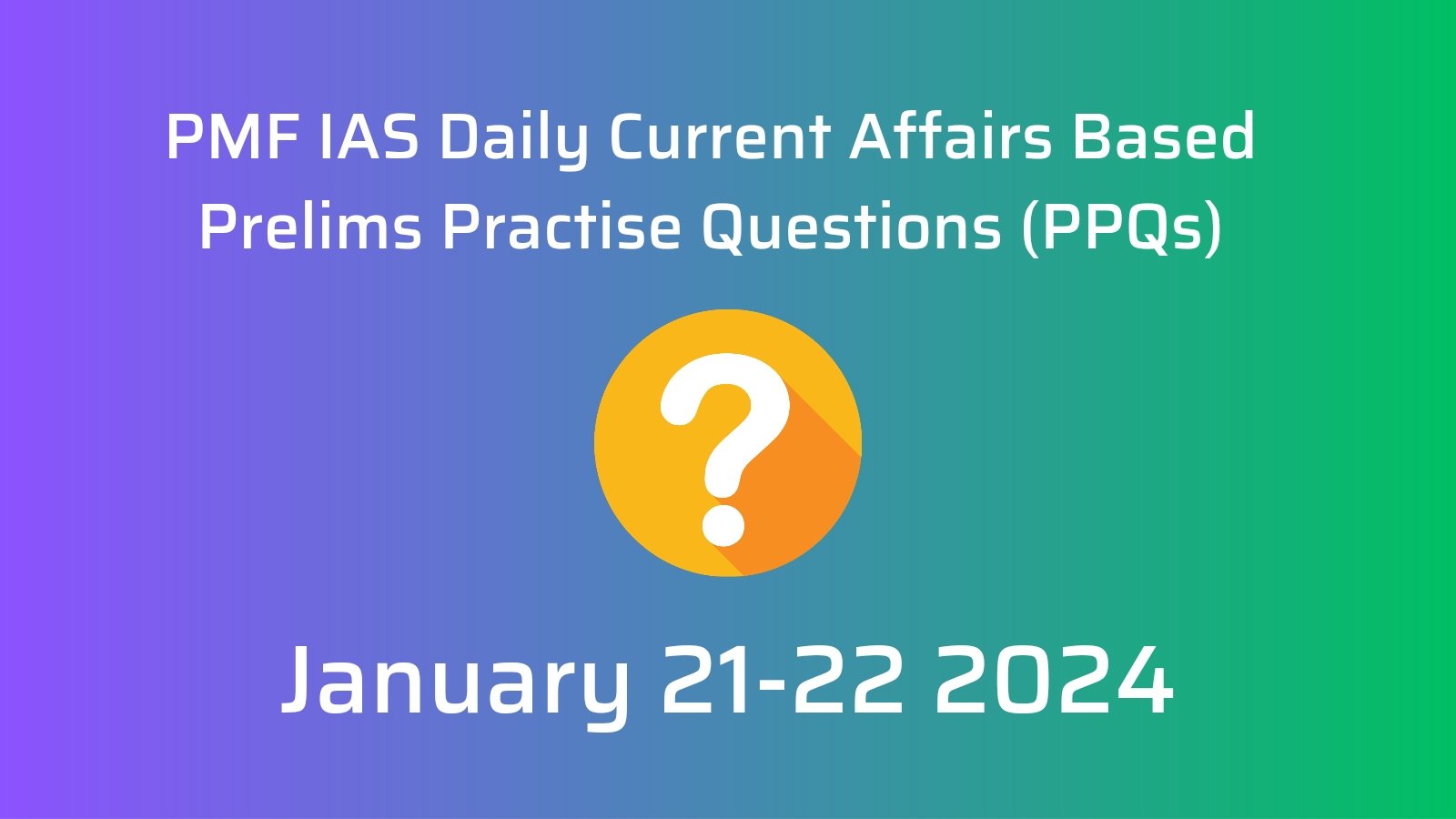
January 21-22 2024 Prelims Practice Questions (PPQs)
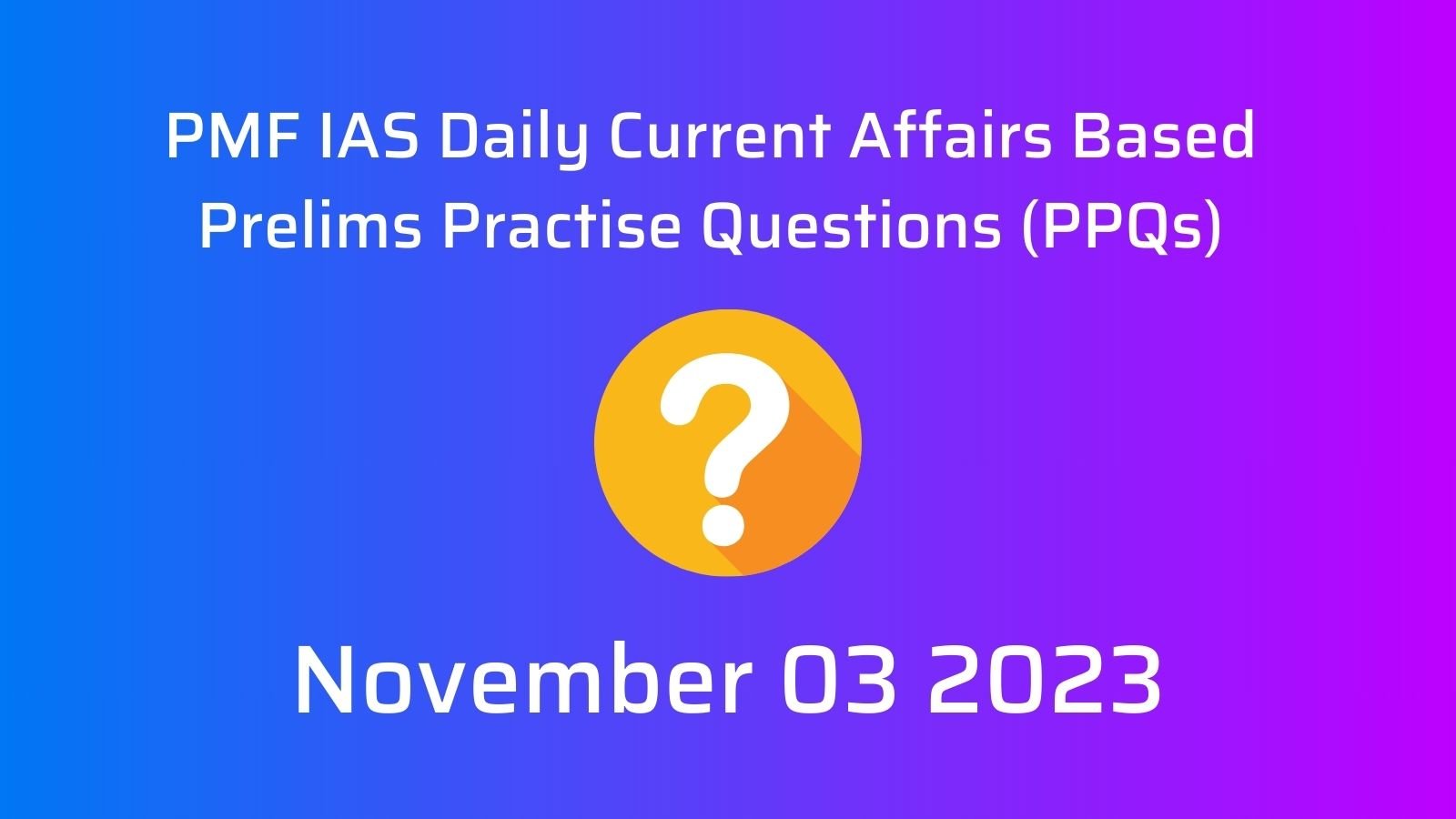
Daily Prelims Practise Questions (PPQs) – November 03 2023
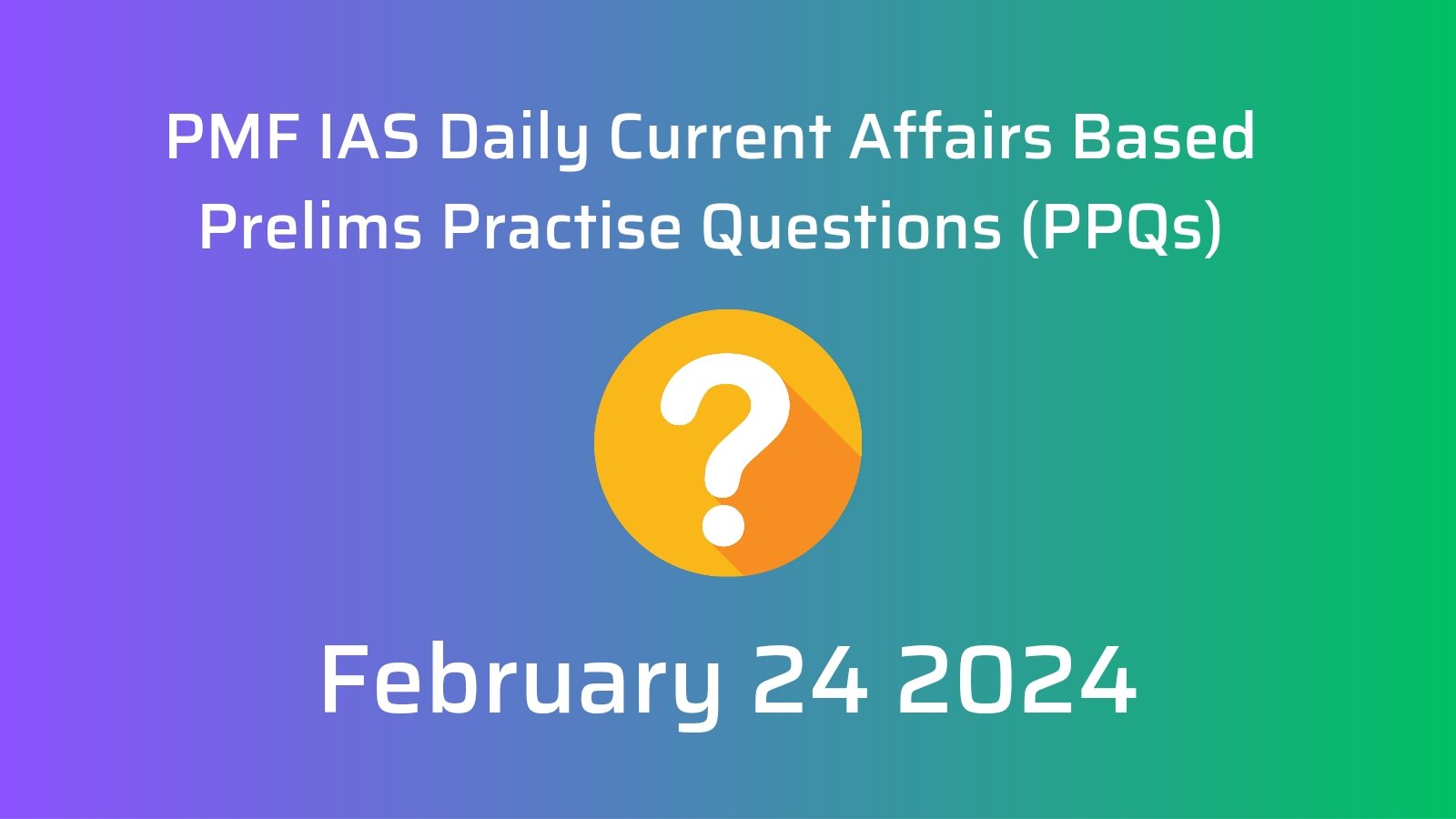
February 24 2024 Prelims Practice Questions (PPQ)
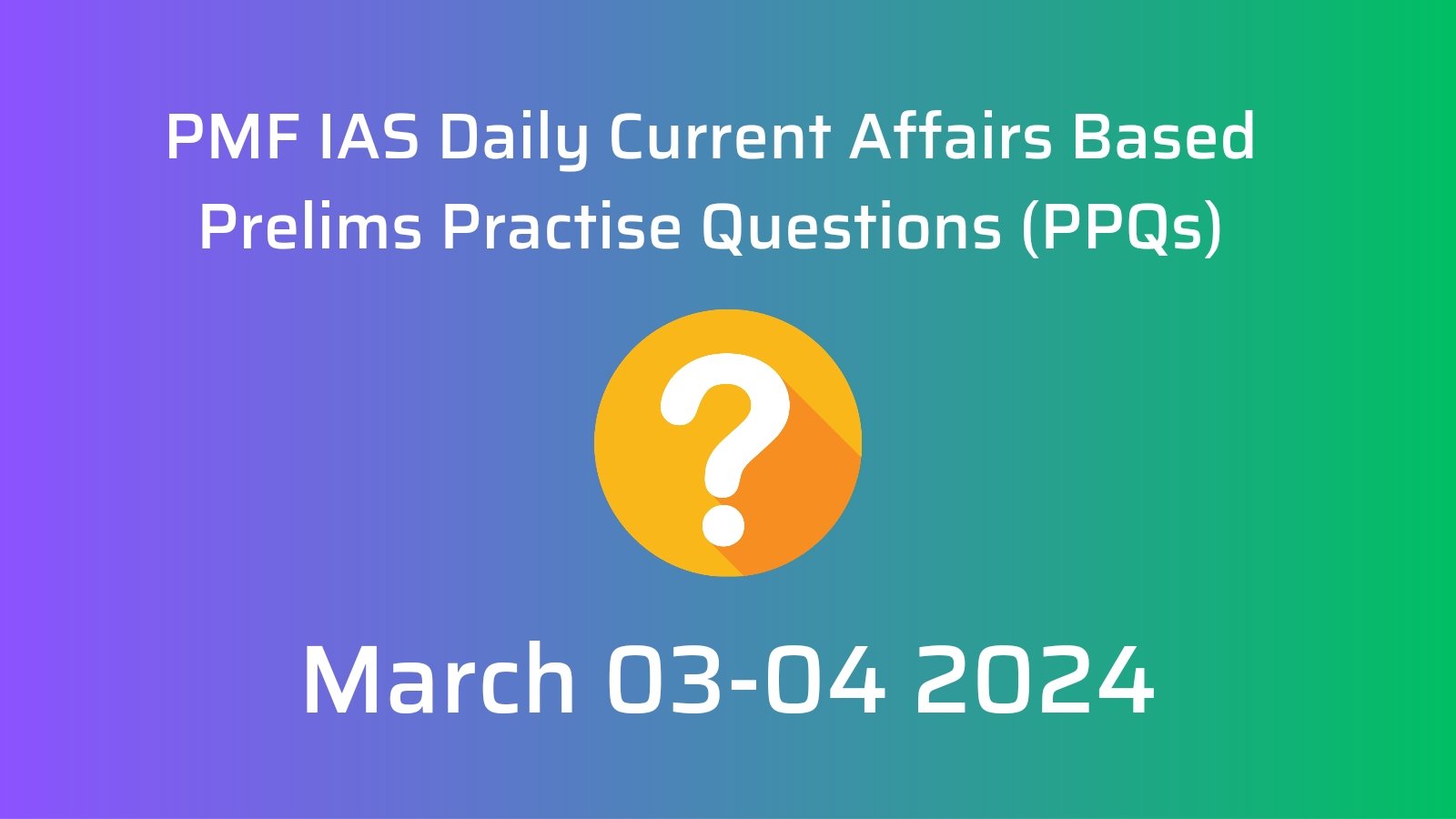
March 03-04 2024 Prelims Practice Questions (PPQs)
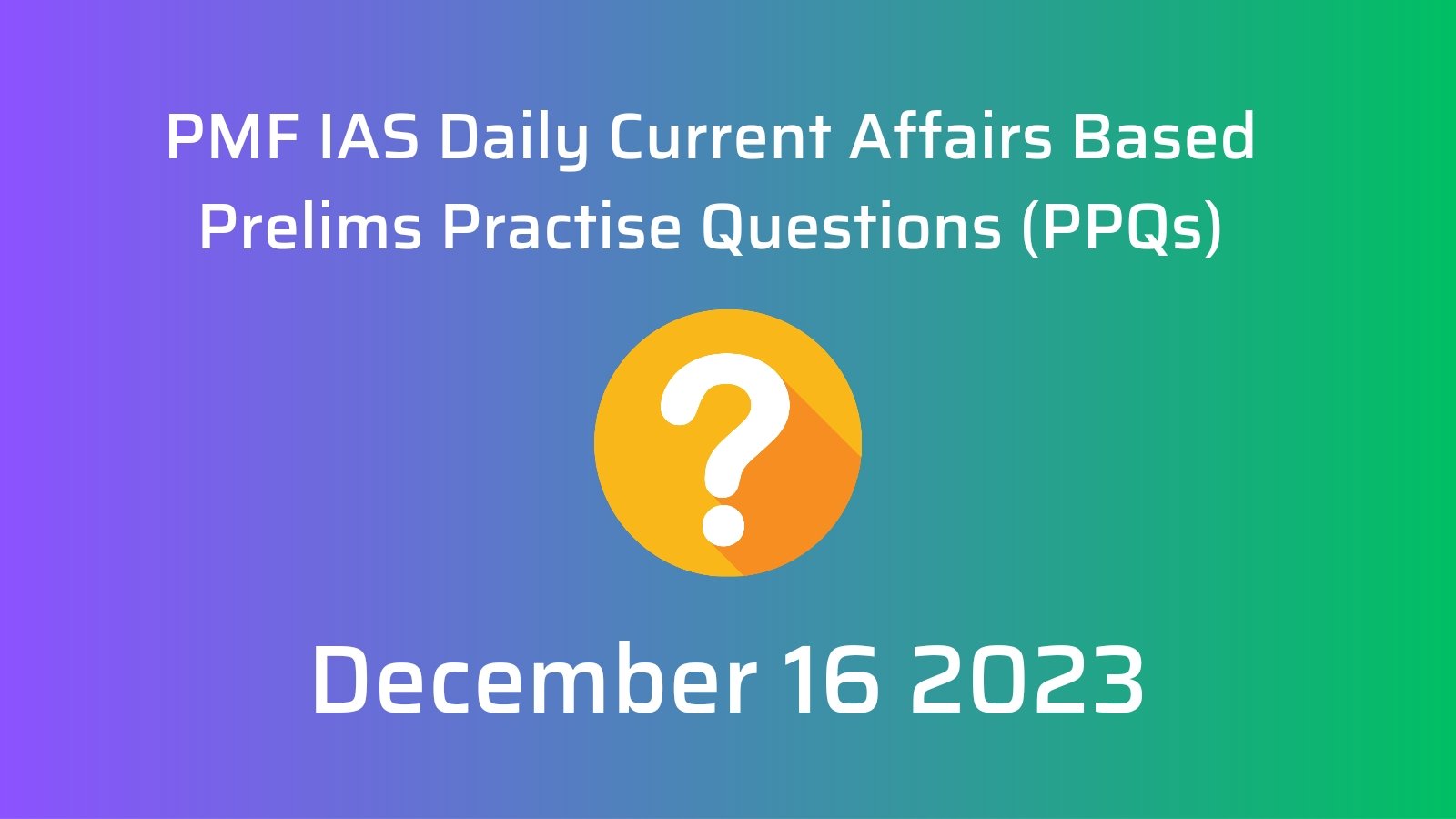
December 16 2023 Prelims Practice Questions (PPQs)
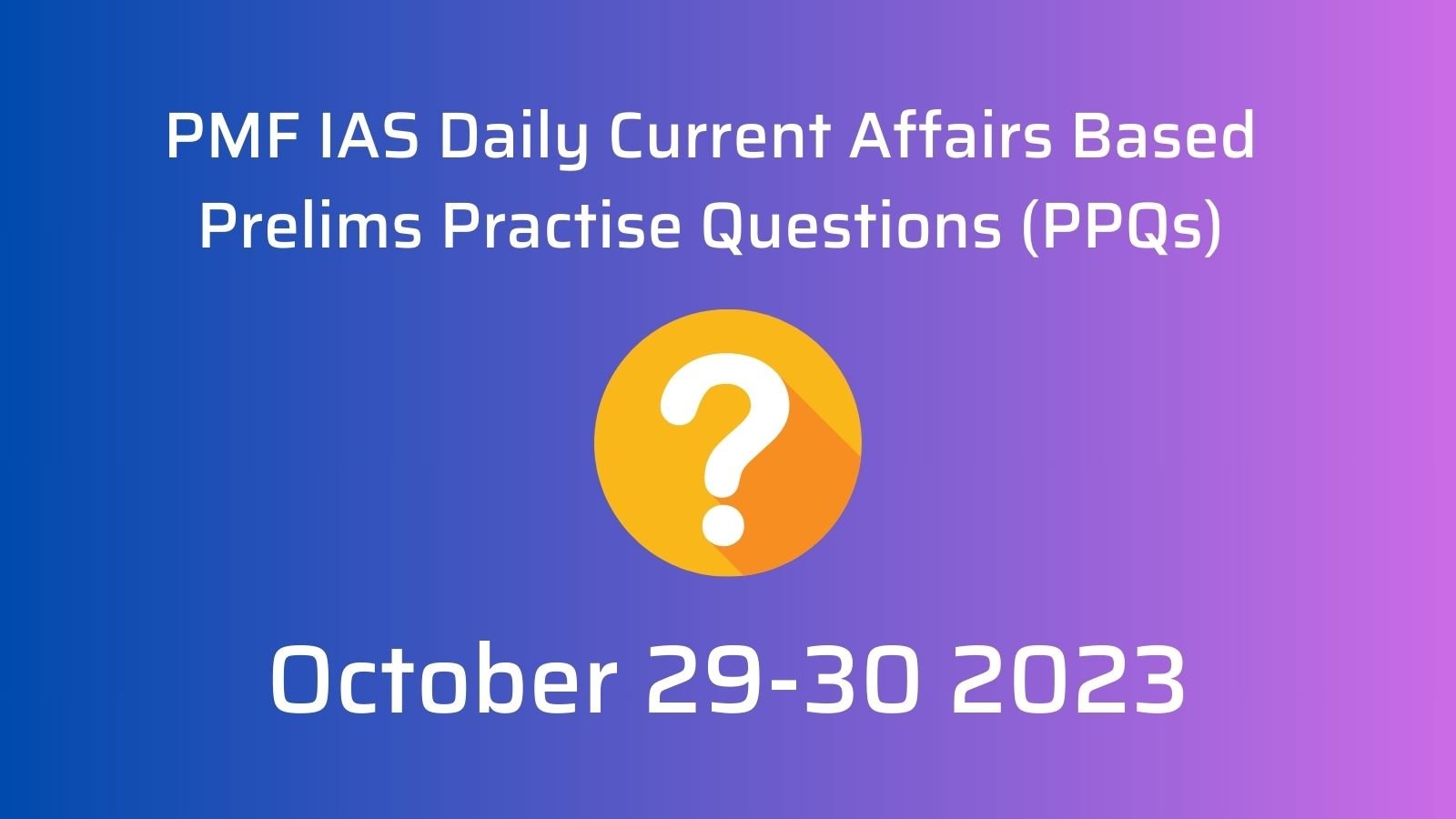
Daily Prelims Practise Questions (PPQs) – October 29-30 2023

January 01-02 2024 Prelims Practice Questions (PPQs)
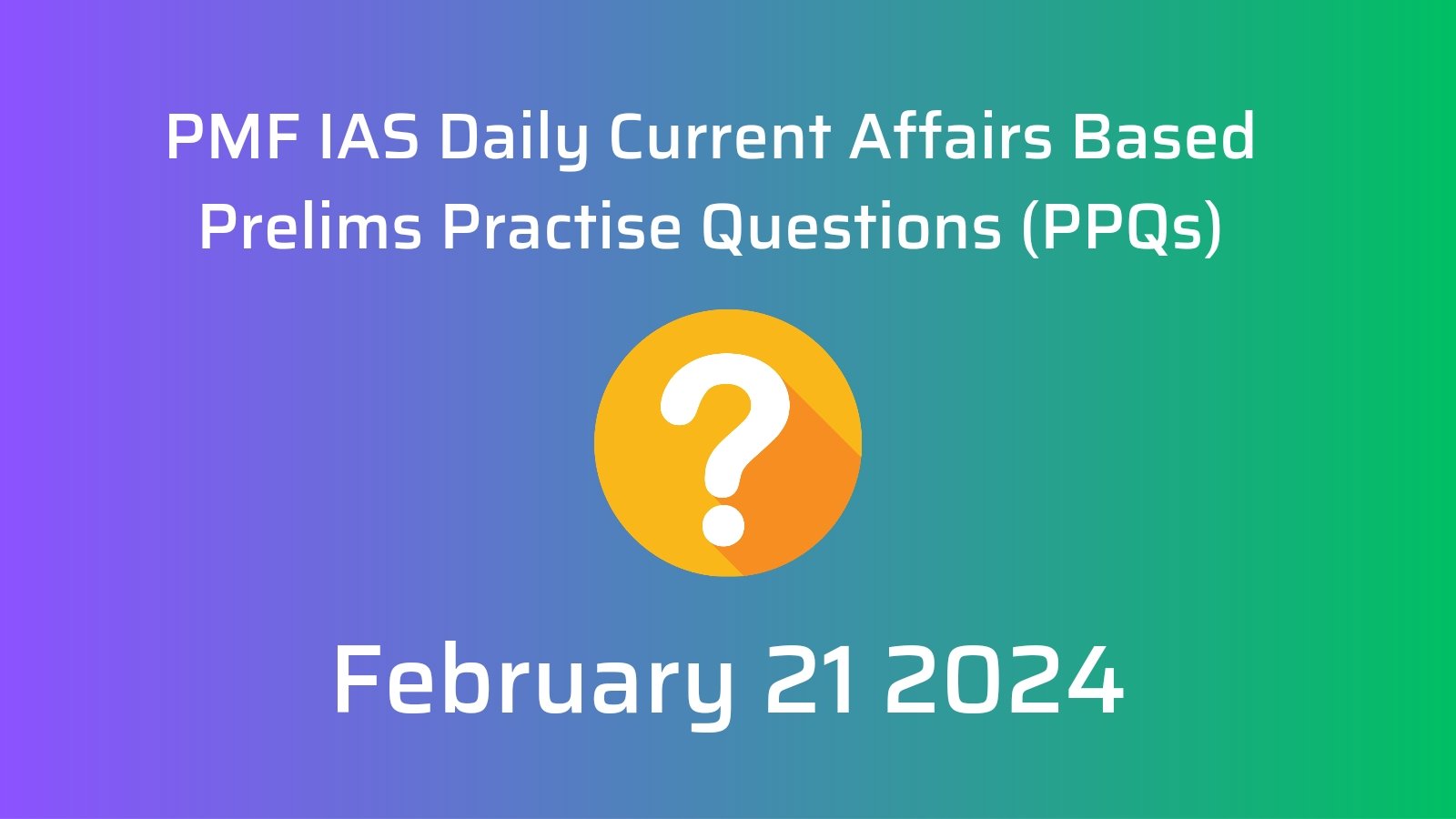




![PMF IAS Environment for UPSC 2022-23 [paperback] PMF IAS [Nov 30, 2021]…](https://pmfias.b-cdn.net/wp-content/uploads/2024/04/pmfiasenvironmentforupsc2022-23paperbackpmfiasnov302021.jpg)


